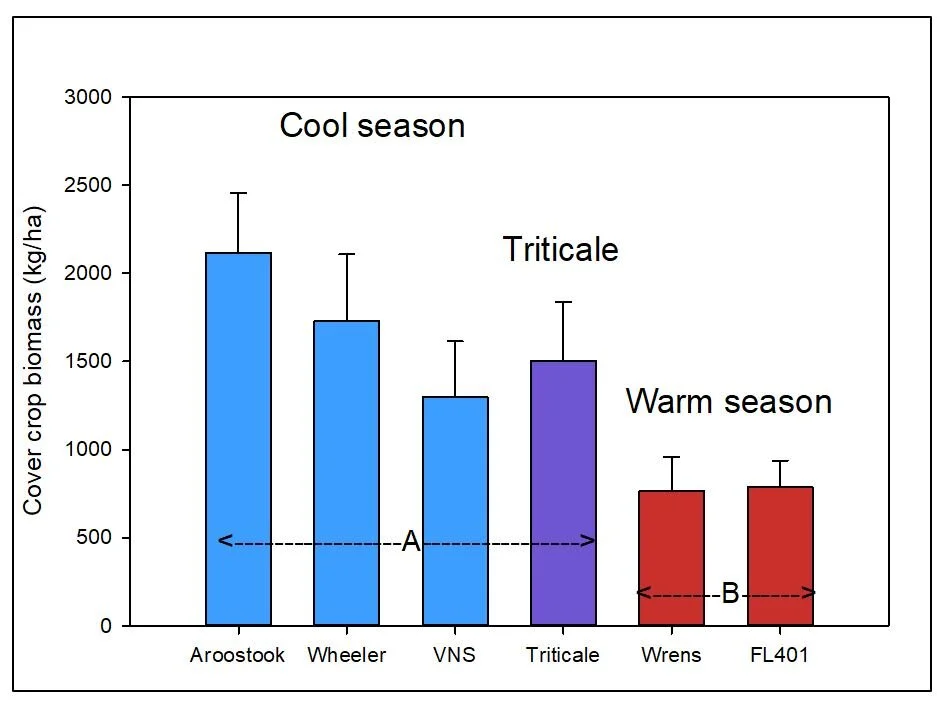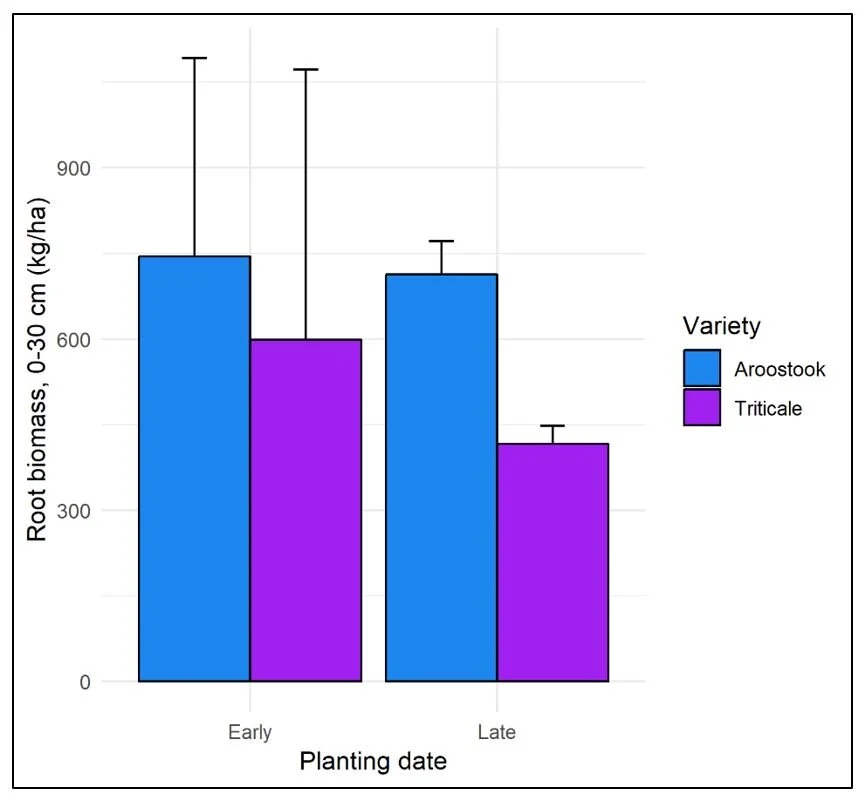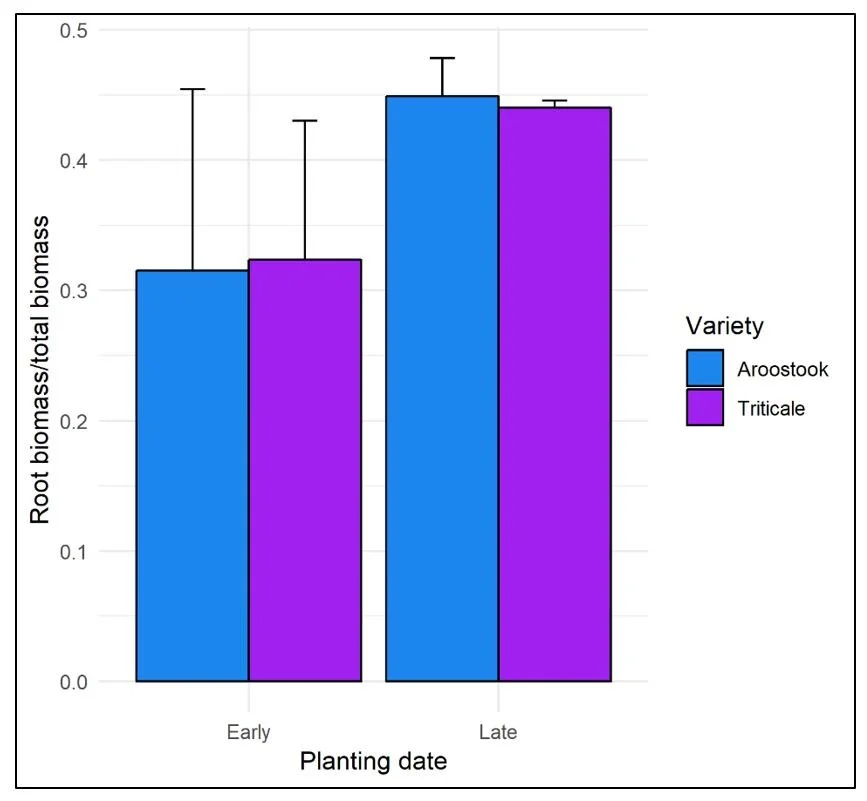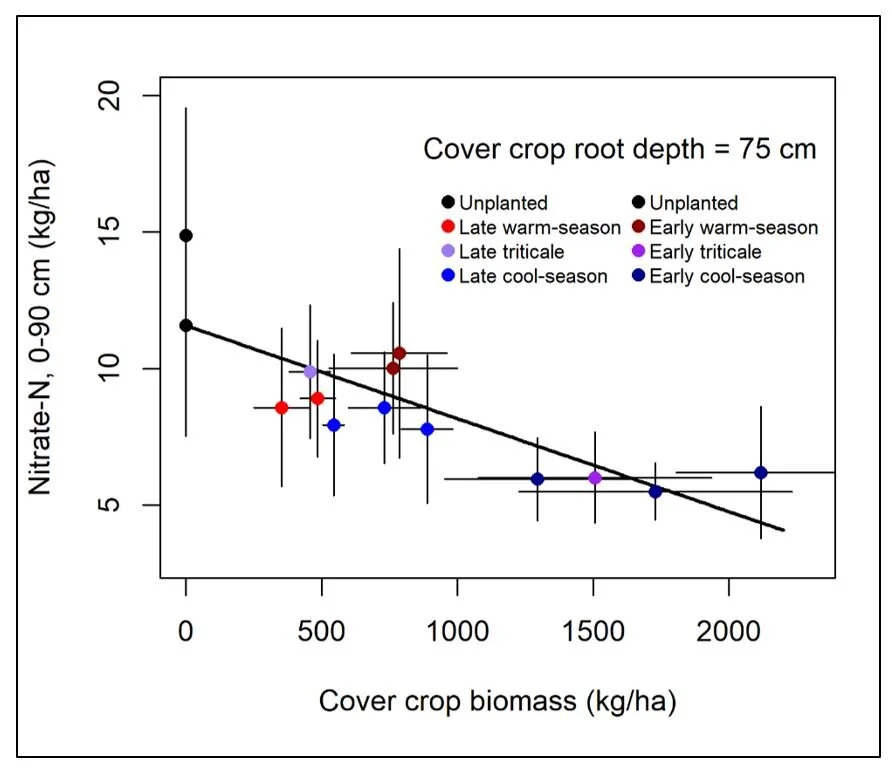Investigating cereal rye cultivars for improved cover crop performance
Principal Investigators: Erin Haramoto and Hanna Poffenbarger
Note that methods and results describe our first year of experimentation; the second year of experimentation is currently underway
Introduction
Cover crops provide a number of benefits to agricultural systems, including soil conservation and nutrient retention, soil carbon sequestration, soil water storage, and weed suppression. Cereal rye is planted on more acres than any other cover crop species in the U.S. because it can reliably produce substantial biomass in a wide range of growing conditions (SARE-CTIC, 2017). With its deep roots, cereal rye also has an outstanding ability to scavenge inorganic N from the soil profile, reducing economically- and environmentally-costly losses of plant-available N during winter months (Thorup-Kristensen, 2009). Thus, of the common small grain cover crops, cereal rye remains an excellent choice and has much potential to provide benefits of cover cropping to Kentucky’s producers.
In order to maximize these benefits, well-adapted cereal rye cultivars should be selected for rapid and complete ground cover, high biomass production, and high potential to suppress weeds. Previous research on a limited number of cultivars conducted in the Midwest and Southeast has shown that cereal rye cultivars differ in aboveground biomass production, total N uptake, weed suppression, and effect on subsequent crop yield. Much of the variation in variety performance can be attributed to where the variety was developed, with varieties developed in northern states (i.e., cool-season varieties) performing better in cold climates and varieties developed in southern states (i.e., warm-season varieties) performing better in mild climates. Because Kentucky is located in the transition zone, deciding between a cool- or warm-season variety is more challenging and the optimal variety may depend on planting date. Potential cover crop planting dates in Kentucky vary considerably; cereal rye may be planted as early as mid-September following an early corn harvest and can be planted through late October if harvest is delayed. Thus, examining the potential biomass production and performance of cultivars planted at different dates is essential information for Kentucky growers seeking to utilize cereal rye cover crops in their production systems.
Among the services provided by cereal rye cover crops, the potential for cereal rye cultivars to have different root growth and N scavenging abilities has not yet been tested. This is an important oversight in cover crop research because roots make up ~15-25% of total cereal rye biomass and can capture inorganic N as deep as 6 feet (Weil and Hirsch, 2018). Moreover, roots are an important way to add organic matter to subsurface layers, particularly in no-till systems where aboveground residues are not incorporated into the soil. In fact, most organic matter in soil originates as root material, in part because they extend deep into the soil, decompose slowly, and promote stable aggregate formation. Research conducted on winter wheat suggests that rooting patterns vary by cultivar (Hodgkinson et al. 1997), but this information is lacking for cereal rye.
Goals and Objectives: The overall goal of this project is to determine which cereal rye cultivars offer the best combination of cover crop benefits to Kentucky producers. The specific objectives are to determine the ability of cereal rye cultivars and triticale, planted at two different dates, to provide the following services to producers:
1. Produce complete ground cover and high aboveground biomass for soil conservation
2. Produce deep roots and scavenge residual soil N
3. Suppress fall- and early spring-emerging weeds during growth
Materials and Methods (Year 1: September 2018-May 2019)
Plot establishment. Two treatment factors, planting date and cereal rye cultivar, were examined using a split plot design at University of Kentucky’s Spindletop Research Farm in Lexington, KY (38.12 N; -84.51 W). The field utilized was previously cropped to corn removed for silage. Soil type was a Maury Bluegrass silt loam (fine, mixed, active, thermic Ultic Hapludalfs). Two planting dates were examined as the main plot factor (“early” and “late”), and cultivar was the subplot factor. We utilized four cereal rye cultivars (including two cool-season cultivars ‘Aroostook’ and ‘Wheeler’ and two warm-season cultivars ‘Florida 401’ and ‘Wrens Abruzzi’), a ‘variety not stated’ cereal rye, triticale (‘NE 426GT’), and a bare ground control. Each combination of treatment factors was replicated four times utilizing a randomized complete block design. Plots measured 10’ wide by 30’ long.
All cover crop seed was planted using a no-till cone-seeder drill. The early planting date was 9/14/18, while the late planting date was 10/24/18. Nitrogen was applied over the whole site (as UAN, 30 lbs of N/acre) on 9/14/18 to simulate a year with residual N remaining in the soil after harvest. Dicamba was applied to a 20’ strip of each plot on 10/25/18 to control emerged weeds.
Data collection.
Objective 1, ground cover and aboveground biomass: Periodic overhead photos were taken to measure the percent ground cover. These were taken from both weed-free and weedy areas to ascertain the proportion of ground cover provided solely by the cover crop. Cover crop and weed aboveground biomass was sampled from the warm-season cultivars on 2/25/19 after a period of cold air temperatures resulted in aboveground biomass mortality. These samples were repeated in all plots on 4/23/19 prior to termination in the weedy and weed-free areas. All cover crop biomass was collected from two 0.25 m2 quadrats in each plot – one from the weedy area and one from the weed-free area.
Objective 2, roots and soil N scavenging: Soil cores (0-90 cm, split into 30-cm segments) were collected just prior to planting in the fall and just prior to cover crop termination in the spring. The soil samples were analyzed for soil moisture and inorganic N content. For cores collected in the spring, root depth was recorded as the maximum visible root tip depth. We are in the process of washing roots from the spring soil samples to determine root biomass, root length, root length density, and root C and N concentrations. Due to the laborious nature of root washing, we are focusing on only two of the cereal rye varieties – Aroostook and triticale.
Objective 3, weed suppression: Weed density was determined on 1/8/19 and 4/23/19 by counting all emerged weeds after identification. Weeds were counted in two 0.25 m2 areas in all plots. Weed biomass was sampled from the weedy area in each plot prior to cover crop termination as described above.
Preliminary data from year one:
In order to determine which cereal rye cultivars offer the best combination of cover crop benefits to Kentucky producers, we evaluated the performance of two cool-season varieties (‘Aroostook’ and ‘Wheeler’), two warm-season varieties (‘Florida 401’ and ‘Wrens Abruzzi’), a variety not stated (‘VNS’), and triticale planted in mid-September and late October of 2018. Our first year of data collection revealed that the optimal variety differed depending on planting date: for early-planted cover crops, the warm-season varieties produced less biomass than the cool-season varieties and triticale (Figure 1); however, for late-planted cover crops, aboveground biomass was similar across varieties and averaged approximately 575 kg/ha (not shown). We believe that cover crop growth of the early-planted warm-season varieties was inferior to that of the early-planted cool-season varieties in year one due to warm, wet conditions in the fall followed by a polar vortex in January, which visibly damaged the early-planted warm-season varieties that had already jointed. Preliminary data suggest that Aroostook cereal rye and triticale produced between 400 and 800 kg ha-1 of root biomass in the top 30 cm (Figure 2). Roots made up ~30% of total biomass for the early planting date and ~45% of total biomass for the late planting date (Figure 3). Weed biomass within the cover crops was not affected by variety, but was greater in the later planted cover crops (340 kg/ha) compared to those planted earlier (170 kg/ha). Density of early-emerging summer annual weeds, like common ragweed and common lambsquarters, was similar across all cultivars; marestail density was also similar across treatments. Weed density, however, was highly variable. Soil nitrate scavenging was positively related to cover crop biomass, and only cool-season varieties significantly reduced springtime soil nitrate relative to the unplanted control (Figure 4). Our first-year results indicate that cereal rye cultivars differ in cover crop performance. However, additional site-years will be needed to determine if the performance of varieties is consistent across environments.
Figure 1. Average aboveground biomass for early-planted cover crops, sampled in April 2019, from Lexington, KY. Error bars represent one standard error. Cover crops were planted on 9/12/18 and are grouped into cool-season cereal rye (blue), warm-season cereal rye (red), and triticale (purple). Groups with the same capital letter are not significantly different. No differences in biomass were detected for late-planted cover crops (not shown).
Figure 2. Root biomass at the time of cover crop termination for early- and late-planted Aroostook cereal rye and triticale. Data are derived from two of the four replicates because root data collection is still in progress. Error bars represent ± one standard error.
Figure 3. Proportion of total cover crop biomass attributed to roots in the top 30 cm. Data are derived from two of the four replicates because root data collection is still in progress. Error bars represent ± one standard error.
Figure 4. The amount of nitrate-N present in the soil profile at the time of cover crop termination in response to cover crop biomass level. Colors represent experimental treatments (late = late-planted; early = early-planted; warm-season = Wrens Abruzzi and FL401; cool-season = Aroostook, Wheeler, and Variety Not Stated). Error bars represent ± one standard error.
References:
Hodgkinson L, Dodd IC, Binley A, Ashton RW, White RP, Watts CW, Whalley WR (2017) Root growth in field-grown winter wheat: Some effects of soil conditions, season and genotype. Eur J Agron 91: 74-83
SARE-CTIC (2017) Cover Crop Survey. USDA, West Lafayette, IN
Thorup-Kristensen K (2009) Winter wheat roots grow twice as deep as spring roots, is this important for N uptake and N leaching losses? Plant Soil 322: 101-114
Weil R, Hirsch S (2018) Deep soil nitrogen: A resource for sustainability in the mid-Atlantic using early cover crops. SARE Report. Washington, D.C.




